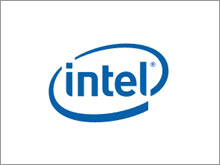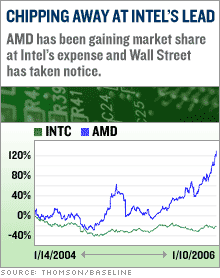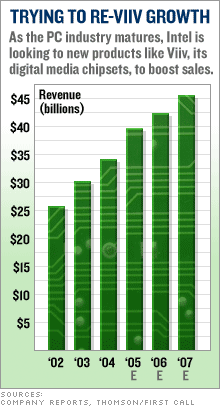|
Time to 'leap ahead' with Intel?
Stock Spotlight: With a slew of new products and solid earnings due, is the No. 1 chipmaker a buy?
NEW YORK (CNNMoney.com) - If Intel has its way, 2006 will be a leap year. The world's largest chipmaker recently changed its tag line to "Leap Ahead" amid hopes that a string of new products and partnerships will keep its sales, profits and stock price leaping ahead as well. Over the past 12 months, shares of Intel (down $0.27 to $25.52, Research) stock have risen about 18 percent.
On Tuesday, Intel should report healthy fourth-quarter results. Analysts expect earnings to come in at 43 cents a share, up 30 percent from last year, according to Thomson/First Call. Sales are estimated to reach $10.56 billion, an increase of 10 percent from a year ago. While Intel has plenty of reasons to be upbeat, there is some cause for concern as well. The company had to contend with supply problems and market share gains by top rival Advanced Micro Devices last year. Some fear Intel may not be doing enough to diversify as the personal computer and server markets mature. As such, Intel's stock lagged the performance of AMD and many other large semiconductor companies in 2005. Still, most analysts are bullish on the company's prospects. So is it worth chipping in for some shares? Intel turns inside out
Since Paul Otellini took over as Intel CEO in May, the nearly 40-year old company has been doing everything it can to prove it's still a cutting edge tech firm. The company scrapped its trademark Intel with the lowered "e" logo and "Intel Inside" catchphrase for the "Leap Ahead" slogan earlier this month. Intel has a key new partner to help give it credibility too: Apple. On Tuesday, Apple CEO Steve Jobs revealed the first Macs running on Intel's Core Duo chip and added that Apple's entire line of Macs would be stocked with Intel chips by the end of 2006. That's about six months ahead of schedule. The company is also trying to branch out beyond its PC and server roots in order to cash in on the lucrative digital media market. At the Consumer Electronics Show in Las Vegas this month, Intel made clear it wanted to break into consumers' living rooms when it unveiled its new Viiv chipset. Viiv (rhymes with five) chips are specifically for entertainment PCs that will function more like TVs and allow users to download, manage and view various types of digital content. Still, some analysts are skeptical of whether Viiv will lead to sizable sales and profits anytime soon. "Viiv is very early and in terms of its benefit for Intel, I think we're not going to see anything from it really in 2006," said Eric Ross, an analyst with ThinkEquity Partners. Cody Acree, an analyst at Stifel Nicolaus & Co., said the verdict is still out on whether the TV will ever be supplanted as the home entertainment appliance of choice. Intel vs. AMD
Fortunately for Intel, it still rules in microprocessors, the chips that run most PCs and servers. But AMD (Research) is gaining ground. Thanks to several technological advances, AMD has made significant inroads into the laptop and server markets against Intel. In addition, Intel stumbled a bit late last year when it was unable to produce enough chips to meet the demand of its customers. Chip research firm iSuppli estimates that AMD's microprocessor sales jumped 13.8 percent from the third quarter to the fourth quarter, compared to a 6.4 percent gain for Intel. Kevin Rottinghaus, an analyst with FTN Midwest Securities, said Intel is working on the supply problem but that it still may not be able to keep up with demand, particularly in low-end PCs. That could mean that Intel may lose more business to AMD. Still, others think the supply concerns are overblown. Apjit Walia, an analyst with RBC Capital Markets, said the company's production problems should be resolved by the second quarter of this year. And Intel still has a substantial lead over AMD, with an estimated microprocessor market share of 82.5 percent in the fourth quarter, compared to AMD's 11.9 percent share, according to iSuppli. David Wu of Global Crown Capital still sees 2006 as Intel's year. "If they can't beat AMD in 2006 they should be ashamed of themselves," said Wu, adding that Intel's substantial investment in research and development should enable it to gain back ground from AMD in the desktop and server markets and help Intel widen its lead in notebooks, among its more profitable business lines. Processing the future
So what does all this mean for Intel stock? Although concerns about a slowdown in PC sales in the U.S. could hurt the stock, RBC Capital's Walia said the PC market was still going strong globally, especially in Asia. "Intel has seen PC demand increase, with a lot of it from the emerging world, and that's helping them," said Walia. With the stock trading at about 16 times 2006 earnings estimates, Intel seems like a bargain. Profits are expected to grow 14 percent this year and 15 percent, on average, for the next few years. The company is also buying back stock, which should boost earnings per share, and pays a dividend that yields 1.2 percent, attractive for a tech company. Sure, AMD is expected to grow at a faster rate but its stock more than reflects that, trading at 43 times 2006 earnings estimates. So that's all the more reason to not get bearish on Intel, according to ThinkEquity's Ross, who has a price target of $30 for Intel, about 15 percent above current levels. With all that in mind, investors have plenty of reasons to leap aboard Intel stock. None of the analysts quoted in the story own shares of Intel nor do their firms have a banking relationship with Intel. ____________________ Apple CEO Steve Jobs says iPod keeps on rockin' -- Click here.
Techs and media firms have the urge to converge. Click here. |
|




